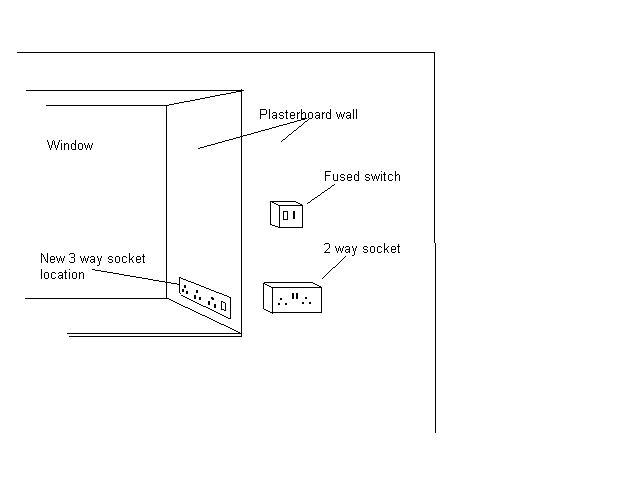Hi there, first post on here.
I'm doing up a spare room and want to move one socket and blank off another. I've attached a picture to help with the explanation. I'm told the room used to be a kitchen years ago and so has one or two random blanking plates and switches tha tseem to do nothing.
It's a plasterboard wall which has 1 fused switch (no socket) and a 2 way switched socket. Both of these stand proud of the wall (not flush fit) and I want to put a wardrobe there which needs to be right up against the wall.
What I want to do is get rid of the fused switch (this seems to have no effect on any other socket when switched on or off). A flush blanking plate would be fine as far as finish is concerned as the wardrobe will cover it. Also, I want to relocate the double socket round the corner of the wall, preferably with a flush fit 3 or 4 way replacement.
I understand and have read about cutting out the palster board and fitting recessed boxes but have some hopefully very simple questions about the electrics:
Blanking plate - Do you just connect witres to 'dead end' terminals in these? Are there different types?
2 way to 3 or 4 way socket - Will I have to modify the wiring, or can the existing power the new socket?
Cable lengthening - What's the best connection method? Are choc-blocs fine?
Any advice much appreciated.
Cheers,
Frosty
I'm doing up a spare room and want to move one socket and blank off another. I've attached a picture to help with the explanation. I'm told the room used to be a kitchen years ago and so has one or two random blanking plates and switches tha tseem to do nothing.
It's a plasterboard wall which has 1 fused switch (no socket) and a 2 way switched socket. Both of these stand proud of the wall (not flush fit) and I want to put a wardrobe there which needs to be right up against the wall.
What I want to do is get rid of the fused switch (this seems to have no effect on any other socket when switched on or off). A flush blanking plate would be fine as far as finish is concerned as the wardrobe will cover it. Also, I want to relocate the double socket round the corner of the wall, preferably with a flush fit 3 or 4 way replacement.
I understand and have read about cutting out the palster board and fitting recessed boxes but have some hopefully very simple questions about the electrics:
Blanking plate - Do you just connect witres to 'dead end' terminals in these? Are there different types?
2 way to 3 or 4 way socket - Will I have to modify the wiring, or can the existing power the new socket?
Cable lengthening - What's the best connection method? Are choc-blocs fine?
Any advice much appreciated.
Cheers,
Frosty








